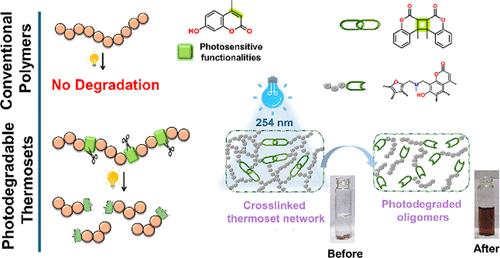光降解的生物基聚苯并恶嗪:朝着圆形热固性发展
IF 5.2
1区 化学
Q1 POLYMER SCIENCE
引用次数: 0
摘要
生物基聚苯并恶嗪(PBz)热固性树脂由于其优异的耐热性、机械性和耐化学性,正在成为一种有前途的高性能树脂。虽然基于香豆素的解聚策略已经成功地建立在各种聚合物中,但它们在PBz光降解中的潜力仍未被探索。为了提高其可持续性,本研究引入了一种开发化学可解构pbz的新策略,该策略保留了传统pbz的性能。我们报道了一种香豆素功能化的单功能苯并恶嗪单体(Co-fa)的合成,然后通过[2 + 2]光环加成得到环丁烷桥接的双功能单体(Co-fa)di。与Co-fa和传统的双酚基苯并恶嗪相比,该二聚体单体具有显著增强的聚合性。所得聚(Co-fa)二热固性树脂表现出优异的热稳定性、机械强度和耐溶剂性。关键是,它在254 nm的紫外线照射下进行了有效的光降解,使光引发的解聚成为可溶的碎片,随后进行了重交联。这验证了它的可回收性和可重复使用性,建立了一个动态和响应的材料平台。这项工作提出了一种可扩展和通用的方法来制造可熔融加工的光降解PBz热固性材料。基于香豆素的光化学的集成不仅实现了寿命终止管理,而且为适合微制造、电子、数据加密和其他高级应用的光模压材料的开发铺平了道路。本文章由计算机程序翻译,如有差异,请以英文原文为准。

Photodegradable Biobased Polybenzoxazines: Toward Circular Thermosets
Biobased polybenzoxazine (PBz) thermosets are emerging as a promising class of high-performance resins due to their exceptional thermal, mechanical, and chemical resistance. While coumarin-based depolymerization strategies have been successfully established in various polymers, their potential in PBz photodegradation remains unexplored. To advance their sustainability, this study introduces a novel strategy for developing chemically deconstructable PBzs that retain the performance of their conventional counterparts. We report the synthesis of a coumarin-functionalized monofunctional benzoxazine monomer (Co-fa), followed by its [2 + 2] photocycloaddition to yield a cyclobutane-bridged bifunctional monomer, (Co-fa)di. This dimeric monomer exhibited significantly enhanced polymerizability compared with both Co-fa and traditional bisphenol A-based benzoxazines. The resulting poly(Co-fa)di thermoset demonstrated superior thermal stability, mechanical strength, and solvent resistance. Crucially, it underwent efficient photodegradation under 254 nm UV irradiation, enabling light-triggered depolymerization into soluble fragments and subsequent recross-linking. This validates its recyclability and reusability, establishing a dynamic and responsive material platform. This work presents a scalable and versatile approach for fabricating melt-processable photodegradable PBz thermosets. The integration of coumarin-based photochemistry not only enables end-of-life management but also paves the way for the development of photopatternable materials suitable for microfabrication, electronics, data encryption, and other advanced applications.
求助全文
通过发布文献求助,成功后即可免费获取论文全文。
去求助
来源期刊

Macromolecules
工程技术-高分子科学
CiteScore
9.30
自引率
16.40%
发文量
942
审稿时长
2 months
期刊介绍:
Macromolecules publishes original, fundamental, and impactful research on all aspects of polymer science. Topics of interest include synthesis (e.g., controlled polymerizations, polymerization catalysis, post polymerization modification, new monomer structures and polymer architectures, and polymerization mechanisms/kinetics analysis); phase behavior, thermodynamics, dynamic, and ordering/disordering phenomena (e.g., self-assembly, gelation, crystallization, solution/melt/solid-state characteristics); structure and properties (e.g., mechanical and rheological properties, surface/interfacial characteristics, electronic and transport properties); new state of the art characterization (e.g., spectroscopy, scattering, microscopy, rheology), simulation (e.g., Monte Carlo, molecular dynamics, multi-scale/coarse-grained modeling), and theoretical methods. Renewable/sustainable polymers, polymer networks, responsive polymers, electro-, magneto- and opto-active macromolecules, inorganic polymers, charge-transporting polymers (ion-containing, semiconducting, and conducting), nanostructured polymers, and polymer composites are also of interest. Typical papers published in Macromolecules showcase important and innovative concepts, experimental methods/observations, and theoretical/computational approaches that demonstrate a fundamental advance in the understanding of polymers.
 求助内容:
求助内容: 应助结果提醒方式:
应助结果提醒方式:


